
Touring the sake brewery of Terada Honke to experience the 340 years of history in natural fermentation!
Kōzaki is a town in northern Chiba Prefecture that is recently enjoying growing popularity as the “Home of Fermentation – Kōzaki”. One of the primary reasons why this town chose “fermentation” as the theme to revitalize its local economy was because it is the home of two established sake breweries that are both operating for more than 300 years and serving now as the iconic local landmarks through their diverse efforts to evolve while sustaining their tradition. The editorial team of haccola gained the privilege this time to visit one of them, “Terada Honke”.
As soon as we arrived, we were welcomed with the warmest hospitality anyone can imagine – “Fermented rice lunch box” that left us all with a big smile!
Once you step in the premise of Terada Honke through the brick gate, the home of natural microbes living freewheelingly, you see a chimney standing at the very end that had once been discharging the steam of the heated rice used for sake-making.
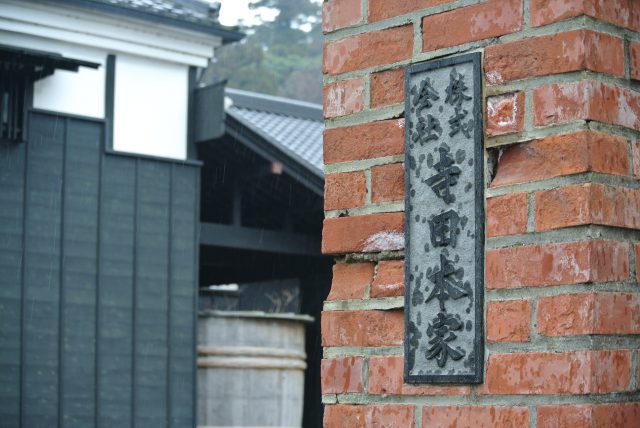
On the day of the tour, it was little rainy when we arrived.
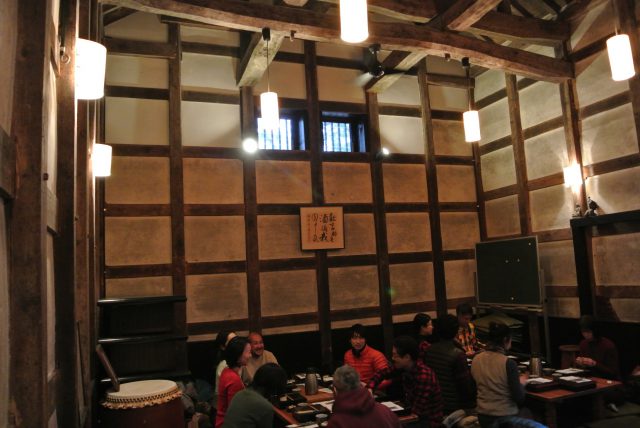
As soon as we arrived, we were escorted to a fabulous dining space that had been refurbished from a room that was once used to store rice.
From a few years ago, the management of Terada Honke has decided to welcome the participants of the brewery tour with a lunch box that features a variety of fermented food cooked according to the recipe of Satomi-san, the second daughter of the former brewery owner who not only runs this legendary house now with her husband, but is also known widely as a culinary expert well-reputed for her research on the use of sake lees as a multi-purposed ingredient.

Any fermented food served in Terada Honke is such a delight that cannot help but make you smile the moment you take a small bite.
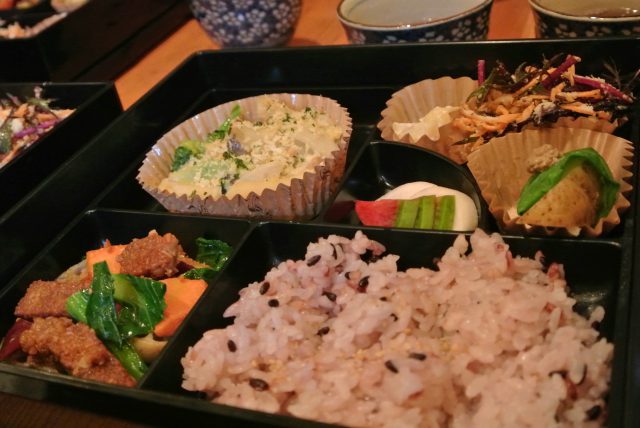
Various small dishes are assorted in the lunch box to entertain the guests, including Satomi-san’s original bagna càuda sauce and cheese mixed with sake lees. Not only do they all taste delicious, but are also very well planned to strike a right balance of different flavors within the confined setting of a lunch box. No wonder there are tour repeaters who say they come all the way looking forward to what kind of high-quality lunch box they will be able to enjoy in their next visit.
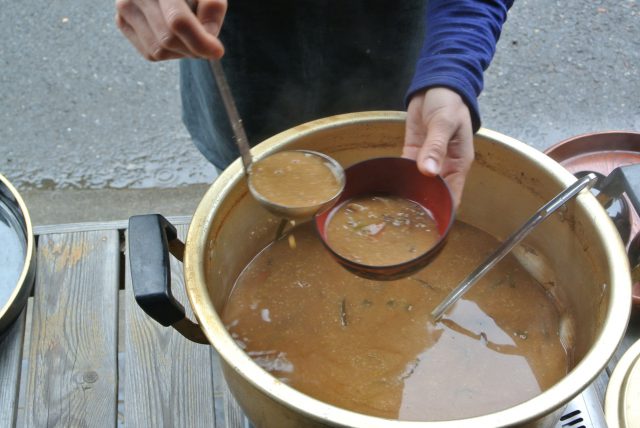
Miso soup containing an abundant amount of sake less definitely warms you up on a chilly day.

The staff members of Terada Honke busily preparing the culinary delights to serve the participants of the brewery tour as their welcome lunch.
After filling our stomach with great fermented food comes the time to learn about the history of this brewery from the current owner, Masaru-san.
When the former owner, Keisuke Terada-san, was running this brewery, Terada Honke in his early days was using food additives to make sake. But after Keisuke-san fell sick and suffered from poor health condition for a while, he began questioning the unnatural way of sake-making that was adopted in the brewery. He also sensed this conventional method was leading to the lack of motivation and harmony among the brewers around that time. Such circumstances triggered Keisuke-san to decide on changing the direction of the brewery and set a new policy to make Terada Honke a sake-maker that only uses naturally derived fermentation method to produce purely organic Japanese rice wine that can truly live up to the old saying that “sake is the best of all medicines”
The background and thought process that led Keisuke-san to reach this decision are described in detail in his book “Hakkōdo” published in 2007. Since its release, this book continues to be a long-seller to this day by gaining wide public support including a large number of business people who consider it as a textbook for those interested in learning about the important roles played by microbes in the course of fermentation.
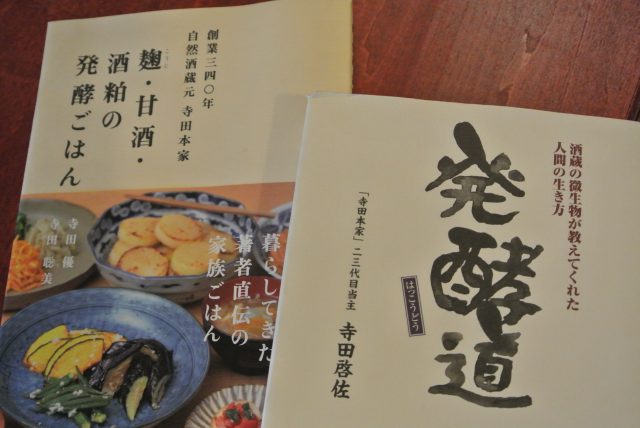
The book “Hakkōdo” (Discipline of Fermentation) written by the former owner, Keisuke Terada-san (on the right) and a recipe book titled “Kōji, Amazake, Sakekasu No Hakkō Gohan”(Fermented Food Using Rice Malt, Sweet Fermented Rice Drink & Sake Lees) co-written by Masaru-san and Satomi-san (on the left)
Masaru-san who became the 24th-generation owner of Terada Honke in 2012 when Keisuke-san passed away is determined to follow in his step-father’s footsteps and continues to pursue the possibilities in the microorganic approach taken in the brewery’s sake-making process that makes full use of the sources of fermentation power that live in harmony with nature.
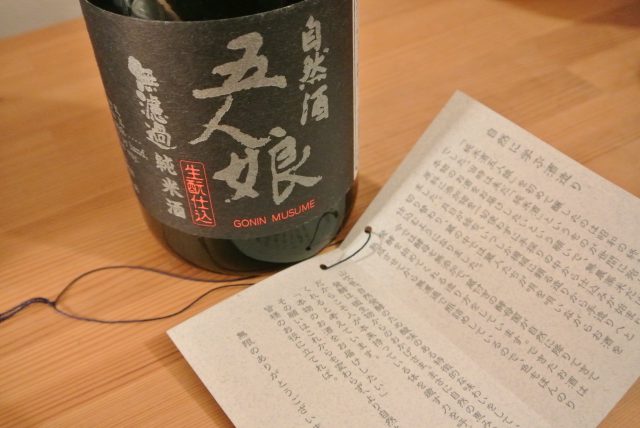
Fermentation is a true form of power derived from natural blessings that cannot be generated without the valuable contributions from microbes. That is why we believe that fermentation has the ability to evoke the healing power that everybody inherently possesses.
Excerpt from the description on the leaflet attached to Terada Honke’s original natural sake brand “Gonin Musume” (Five Daughters)
Hints to build a “good society” found in the workings of microbes
The brewing period of Japanese rice wine is concentrated in the wintertime. In other seasons, Terada Honke keeps its staff busy with various equally important preparatory tasks including the cultivation of natural rice. All the processes from growing rice to producing rice malt, syubo (yeast mash) and moromi (sake mash) that are later squeezed to create the mother water, which is then refined into the final form of natural sake are handled internally by the brewers known as “kurabito”.
The microbes that lend hand to each of these processes are called “kuratsuki”, which exist in countless number and variety in the natural environment of the brewery from long ago.
Each of these microbes gathers around the brewery at the right timing to participate in the fermentation processes managed by the brewers. When one type finishes serving its role, then the next type comes to fulfil its role in the subsequent stage of fermentation. The series of roles played by different microbes start and end in harmonious sequence in the natural environment provided in this brewery.
“The way these microbes contribute to the ongoing fermentation processes in a balanced manner without interfering with one another is literally a microcosm that mirrors our human society where there are people from all walks of life trying to live in harmony so that everyone can be happy. That’s how I look at it,” says Masaru-san. We’ve seen so many members participating in the tour with us nodding at this metaphoric explanation of his philosophy.
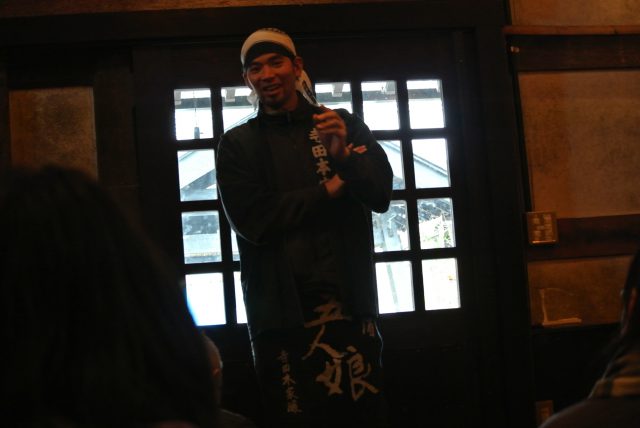
Masaru Terada-san, the current owner, who spoke to the participants of the brewery tour in flowing rhythm, using words and expression that were easy to understand and relate to.
After listening to Masaru-san’s introductory speech, we were all navigated to different areas of the brewery one by one where the step-by-step process of sake production was actually taking place.
This brewery places an 100% trust on microbes. Even the germs carried in by the tour participants are welcomed!
The words we heard from Masaru-san before moving to the brewery took us by surprise. He said, “We welcome all the microorganic friends you have brought along with you today.” And he really meant it. We were all invited into the brewery in our own clothes without wearing any sanitized gear over them.
This policy of not providing any white coats or caps that are normally asked to wear before entering a germ-sensitive area comes from the deep trust this brewery has on microbes as well as from the strong belief that the encounter of new microorganic members brought in by the diverse group of visitors coming from all over leads to the further deepening of fermentation.
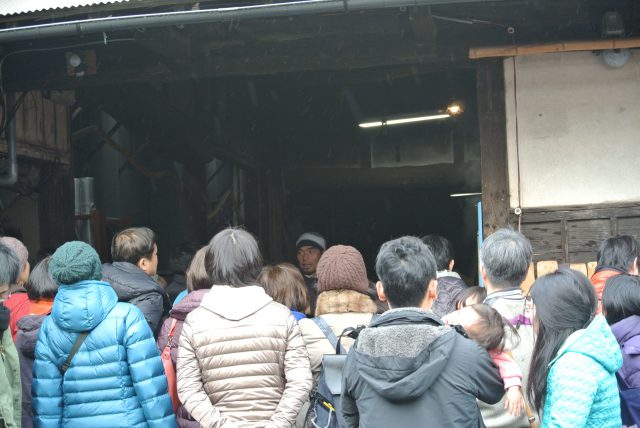
All the visitors are allowed to enter this brewery in their own clothes. What an exceptional sight unthinkable in any other brewery tours!
For the next hour or so, the tour participants were able to enjoy a close look at the different processes of sake production in this brewery, while listening to Masaru-san’s in-depth explanation about each.
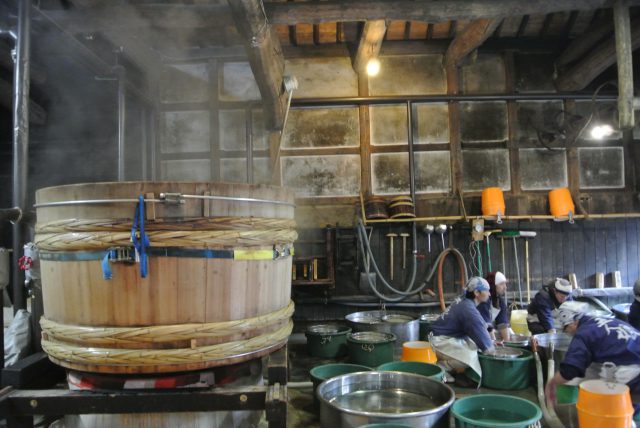
Brewers deftly rinsing the raw rice. For this process, they use the underground water drawn from the well in Kōzaki Shrine located behind the brewery, a tradition they have been keeping since inception. And as a matter of course, they rinse the rice with bare hands no matter how cold the winter water may be. After the thorough rinsing process, they transfer the cleaned rice to a huge cauldron to move on to the next process – rice steaming.
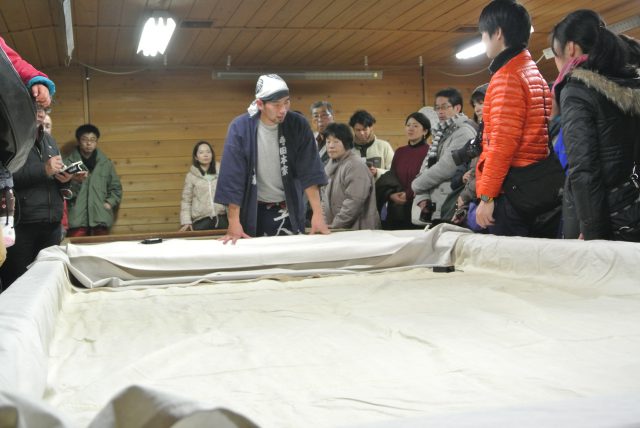
The tour participants were then invited into a room when rice malt is made.
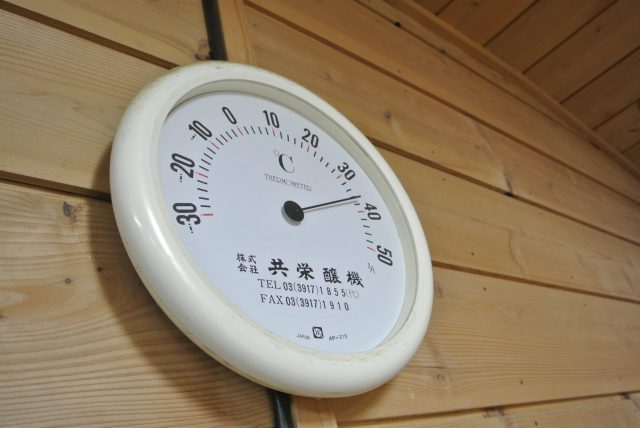
The rice malt room is kept humid and at a temperature ranging precisely between 34〜35℃. Approximately 5 tons of charcoal are embedded in the four walls of this room, making this space a power spot that is locally called “iyashirochi”, which literally means a purified sacred place fit for worshiping, growing plants and trees, and getting energized. In Terada Honke, charcoal is also used abundantly in other parts of the brewery in and out of its premises, including its rice paddies.
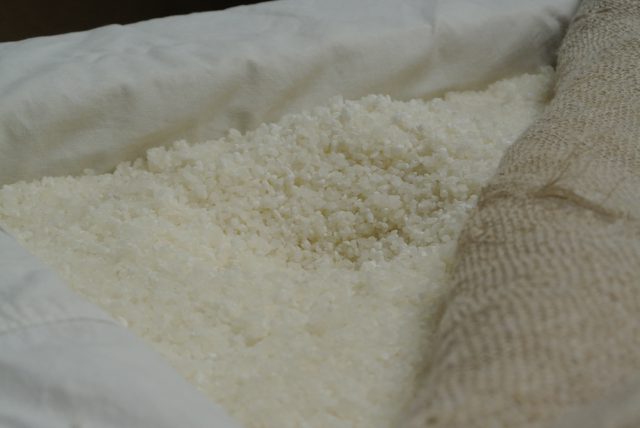
This is the room where rice malt, which is one of the essential starters of sake, is made from steamed rice sprinkled with a specific type of mold called Aspergillus oryzae.

In this room where one could even experience a sense of the sacred, the tour participants were introduced to many tools and devices that were all valuable for the rice malt development process. The photo shows the mold sprinkled rice covered with a blanket to keep the temperature and humidity just right for the rice to transform into malt. A lot of questions were raised from the tour participants.
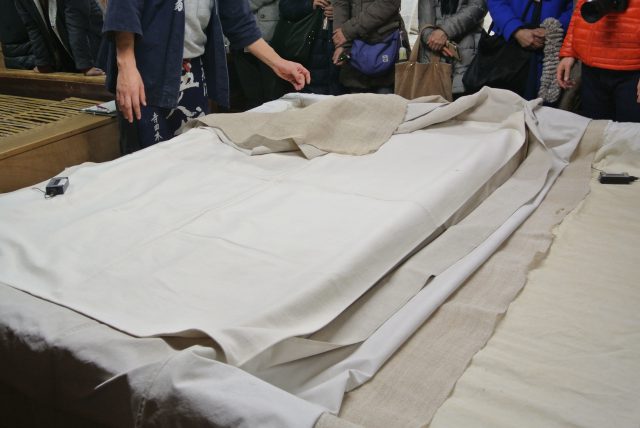
These tools, including the large platform where a vast amount of rice is spread out evenly and the hemp cloth used for spreading the rice are mostly hand-made by the brewers, using natural materials that are highly treasured in this brewery.
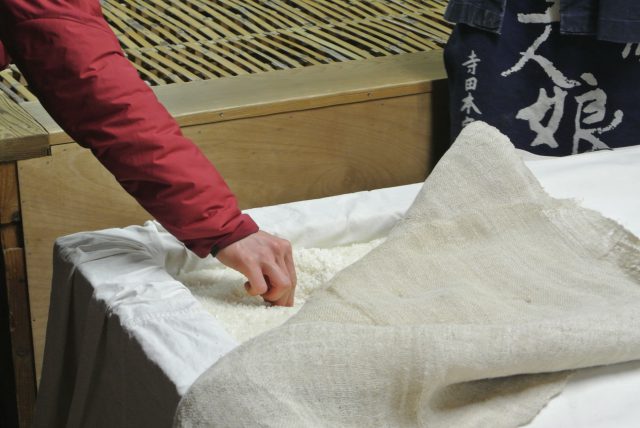
The tour participants were given the chance to try tasting the rice that was in the process of converting itself into malt. We were all deeply moved by this great opportunity to have a foretaste of what will become rice malt that will ultimately serve as the essential ingredient contained in the next bottle of sake produced in this brewery.
In Terada Honke, there is a song always sung by the brewers while they prepare the syubo.
To view the next process, the tour participants were guided to the room where there was a huge tub to mix the seed malt with steamed rice and water to produce the syubo or yeast mash.
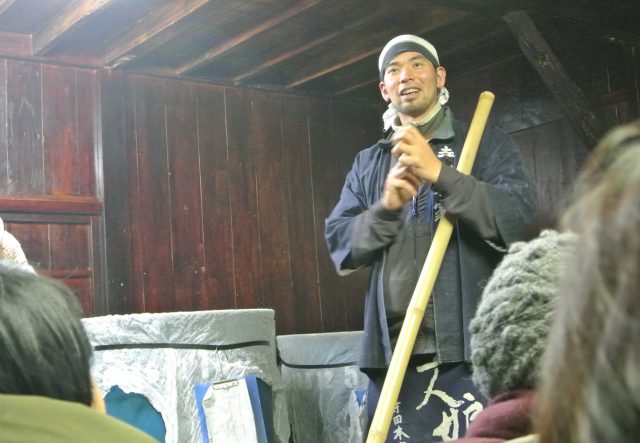
For this process called “kimoto” production, Terada Honke persists on applying the traditional method, because it is considered a phase of particular importance for this brewery.
As a part of the demonstration of what the brewers normally do in this process using the huge wooden tub, Masaru-san sang a passage from the “preparation song” that has been long sung by the brewers, generation after generation, in Terada Honke.
According to Masaru-san’s explanation, this song is sung in unison by all the brewers participating in this process. By singing it altogether, the brewers will be able to unify the degree of their force applied to create the mash. Not only that, this song also contributes to teamwork building by generating a sense of group harmony and spiritual oneness among the brewers while they are singing side by side, staying focused on the mash production. The brewers even decide beforehand the number of verses they should sing each day, based on their observation of the condition of the steamed rice fed to this process, so that they could apply the unified amount of force for a precise length of time to create the best mash possible that day.
“I believe that the microbes residing here can also sense the happy feeling we all share while we are singing,” says Masaru-san.
He continued to tell us that the consistent rhythm created by the brewers during the manual labor in this process, the resonance of their unified singing voices, and the smile of their faces while singing will all be blended into the sake produced in this brewery, making each “a happy bottle of sake” that can bring about a feeling of happiness to all those drinking it.
“But then, I’m actually not sure if our microbial friends have ears to listen to us,” confesses Masaru-san jokingly. We were pretty sure, though, that even this humorous comment was reaching all the microbes filling that room.
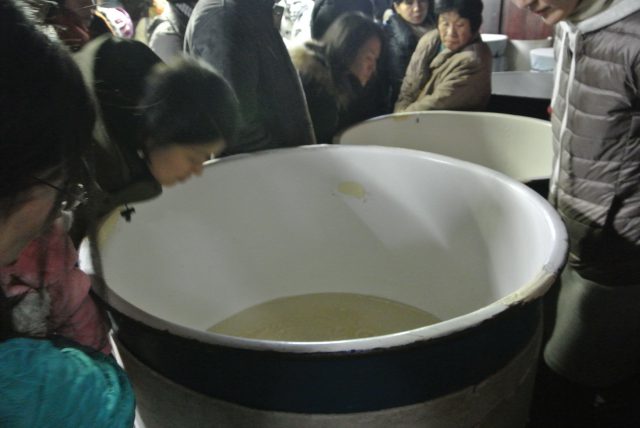
The bubbling sound created by the mash seemed like the microbes in the tub were chatting with each other.
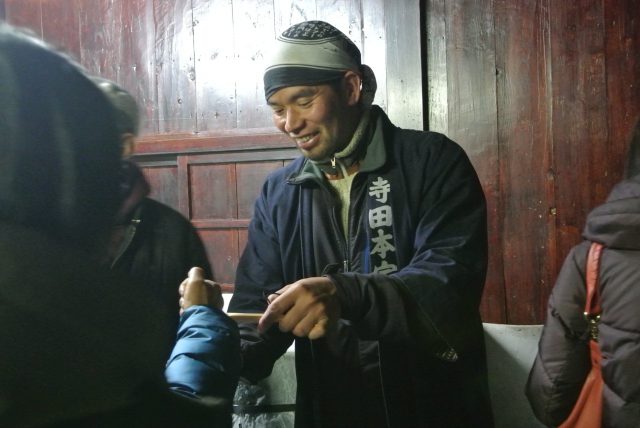
The brewery included frequent opportunities of sample tasting in the tour program. In each occasion, the tour participants couldn’t help respond with a smile and let out a whoop of joy, as though they were embodying the spirit uplifted by each sip of the “happy bottle of sake” offered to them.
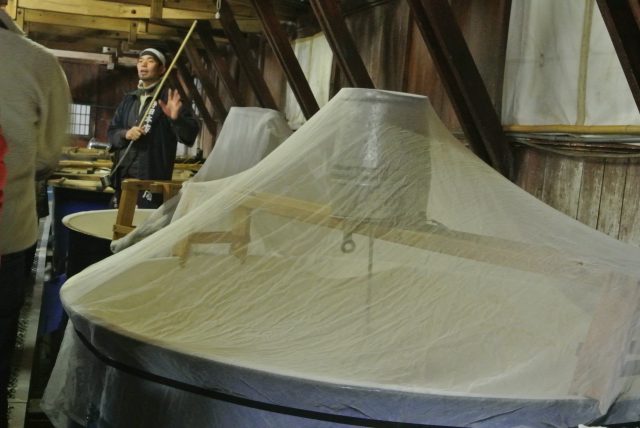
The tour participants were able to witness the wide variety of processes that took place in this brewery, ranging from the very early preparation stage to the final phase where near-finished products were further refined to reach perfection.
From among the brewers appeared a special member from France.
The brewers allocated to different processes in this brewery were all handling their assigned jobs in an organized manner, which Masaru-san described as “this is how we normally work. We are just showing you everything as it is”. The way they operated briskly without any wasteful movements blended well with the setting of this brewery that has been well preserved to maintain a clean and neat ambience, allowing the whole picture to leave a solemn impression similar to that of an aesthetically satisfying Japanese painting.
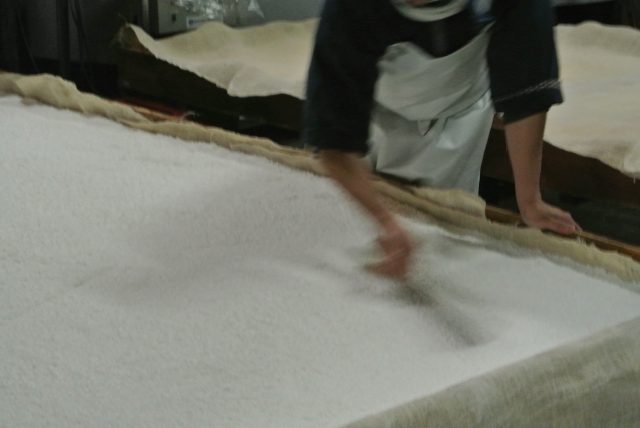
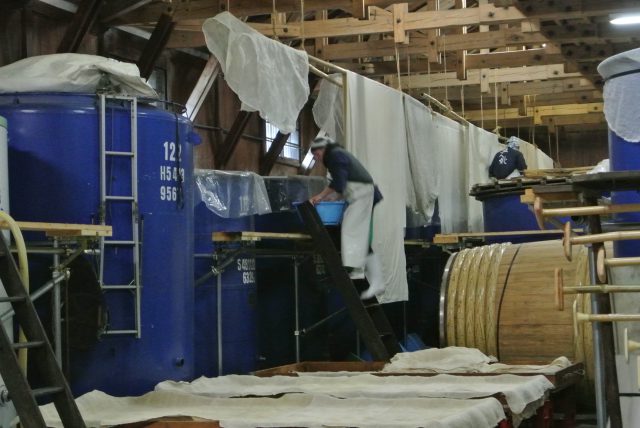
The brewers all looked cool and professional, regardless of gender, making us gaze at them admiringly.
Among them, one member particularly stood out because he did not look like a typical Japanese. We found out that he was a Frenchman named Yannick, who was permitted to participate in the sake brewing process in Terada Honke this year as an intern for one month.
Since haccola is publishing web contents about fermented food in English as well, the editorial staff decided to hold a brief interview with Yannick-san to ask him about his involvement with Terada Honke.
According to what we heard from Yannick-san in this interview, he is a wine brewer based in the Alsace region of France. Before coming to Japan to knock on the doors of Terada Honke, he has been visiting various wineries in Europe and North America to deepen his knowledge about fermentation that he had acquired through self-education. By actually working in these institutions for some time, he has been increasing the learning experience that would help him develop a stronger background as a fermentation specialist.
Yannick-san also revealed that, during his internship in Terada Honke, he has learned a lot from Masaru-san and the brewers, including the chief. When we asked him what would be the one thing that he learned the most, he simply replied, “Everything was equally valuable.”
He then followed up his answer with a long list of learnings he gained from this brewery that he thinks would be a useful set of references for developing his original wine back home. They ranged from further in-depth knowledge about microbes and their workings, the appropriate length of time required for high-quality fermentation, the feeling of happiness communicated to the microbes contributing to the sake production, to the importance of handling the processes manually with your own hands.
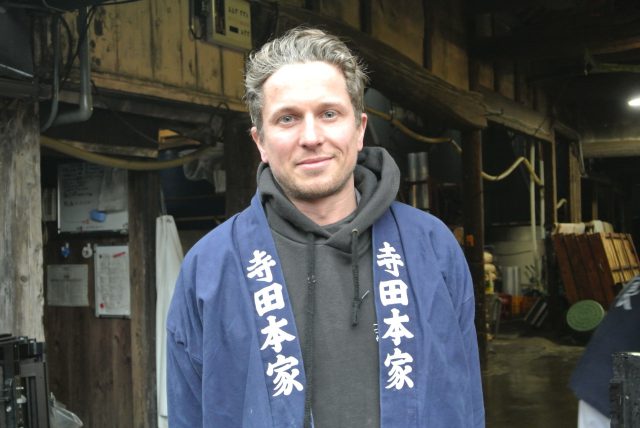
Yannick-san who came from Alsace, a region close to the borders between his home country France and Germany. See how good he looks in the happi coat printed “Terada Honke” that is worn by all the brewers here.
“I can tell you what was the most challenging thing for me when I first got here”, he continued. “That was the Taiso (morning radio gymnastics). In the beginning, I just had to imitate my teammates’ routine movements so that I won’t be left behind. Once I got used to it, I realized how great this morning exercise is for you!” confided Yannick-san with a pleasant smile.
The final hour of the brewery tour was spent to indulge in happiness through sample tasting and shopping of Terada Honke’s original lineup of fermented items.
After visiting various areas in the brewery, the tour participants were all brought back to the space where had our lunch to spend the last hour tasting the samples of Terada Honke’s original products.
The bottles lined in front of us ranged from “Gonin Musume” (Five Daughters), “Shibbota Manma” (Simply Squeezed), “Kaiko Zake” (Nostalgic Sake), “Musubi”, “Daigo no Shizuku” (Drip of Daigo), “Kioke Jikomi” (Brewed in wooden tub) to non-alcoholic “Myghurt”. And we were able to taste all of them!
Naturally, the room was filled with radiating smiles from all the tour participants.

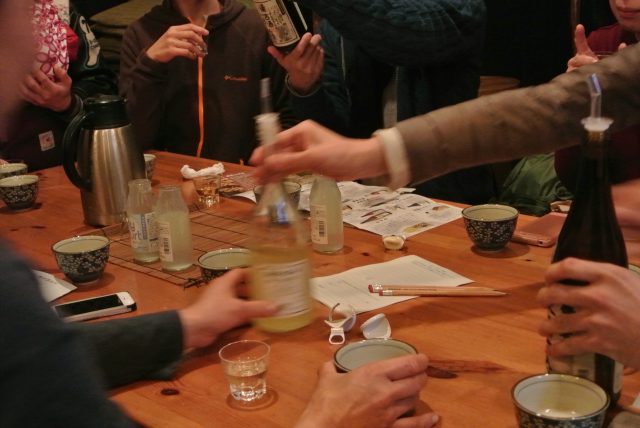
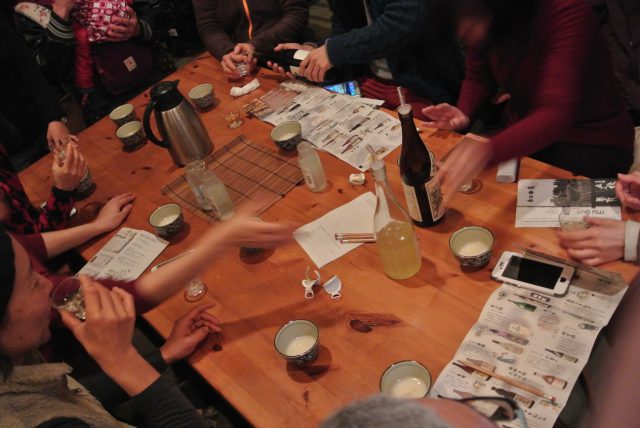
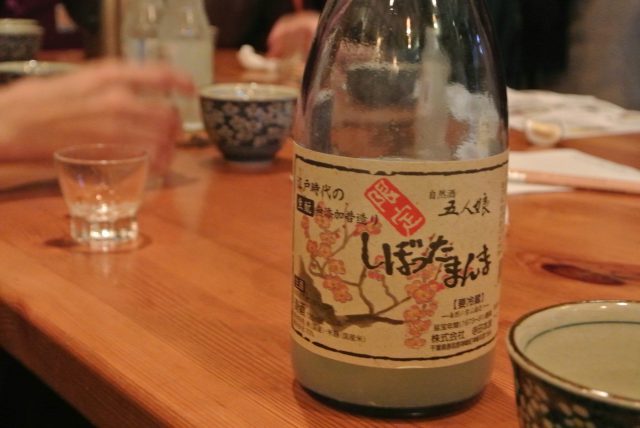
We were also lucky to have a taste of “Shibbota Manma”, the simply squeezed, unfiltered raw sake version of “Gonin Musume”, which is only available as a seasonal limited offer.

Masaru-san stayed with us throughout the time while we were getting excited tasting the splendid products one after another, and was kind enough to answer all the questions we casted on him.
As the closing program of the brewery tour, the brewers had set up an ad-hoc sales booth where we were able to buy not only the sake products we just tasted but also the original seasonings that were used to prepare the welcome lunch, and various other items including the books published by Terada Honke. We saw many tour participants leaving the site with both hands holding paper bags filled with lots of souvenirs they just purchased.

Terada Honke’s 24th-generation owner, Masaru-san, and his wife, Satomi-san, a culinary expert with especially deep knowledge on sake lees. We greatly thank their open mind and welcoming attitude to hold these wonderful tours for ardent sake fans year after year.
Yes, I want to go there too! If that’s what you are thinking, don’t miss March 12!
Terada Honke hosts the brewery tour several times every year in January and February. You need to make an advance reservation to participate in this tour. But unfortunately, the tours scheduled this year are already fully booked.
If you are one of those saying “I can’t wait till next year!” you definitely should keep your day open on March 12th (Sunday) to attend “Sakagura Matsuri” (Brewery Festival in the Home of Fermentation – Kōzaki).
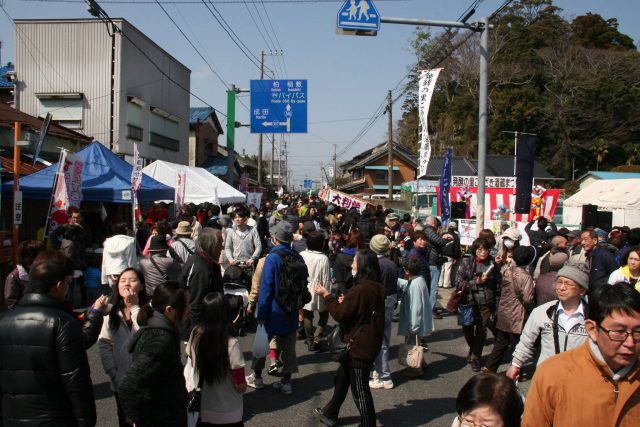

In recent years, this festival has grown into a large-scaled town event that attracts a big crowd counting as many as 50,000 visitors or more.
“Sakagura Matsuri” (Brewery Festival in the Home of Fermentation – Kōzaki) is a town festival that is rapidly growing in popularity these past few years. It evolved into the current format from two sake-featured events that had been hosted separately by two representative local breweries: – Terada Honke’s “Okura Festa”, and Nabedana’s “Kura Matsuri”. Terada Honke and Nabedana, another long-established brewery in Kōzaki known widely for its famous sake brand “Jinyu”, have agreed to hold their respective events on the same day to create a synergic effect.
On the day of this festival, around 200 food stalls and booths will be set up along the streets nearby these two breweries to welcome the visitors, naturally with lots of sake for sales and for sample tasting. There will also be live performances, panel discussions and various other entertaining programs, including the brewery tours. All these events are free and open to everybody without the need of making reservations.
As you can see from the above description, all sake lovers and fans of fermented food should definitely not miss this festival. So why don’t you also consider coming out to Kōzaki this day to spend a good pastime with your family and friends getting fully entertained the whole day with happy sake and fermented food?
We visited the “Home of Fermentation – Kōzaki, a “large brewing center” in a small town
https://haccola.jp/2017_01_01_943/
Terada Honke
http://www.teradahonke.co.jp/
Nabedana Incorporated
http://www.nabedana.co.jp/
Home of Fermentation – Kōzaki
http://hakkou.org/
